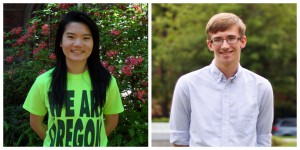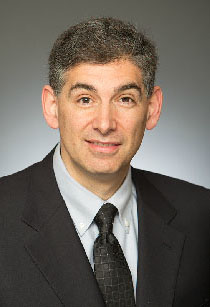
Good luck to David Walla as he defends his thesis for his PhD in Chemistry!
Thursday, May 29th
4:00 PM ~ 331 Klamath Hall
The title of his thesis is “Molecular Regulation of Synaptogenesis in Drosophila”

UO Chemistry and Biochemistry undergrads Kim Ta and John Gillies have been chosen as recipients of prestigious Beckman Research Scholarships for the 2014-15 academic year.
The UO Chemistry and Biochemistry department awards the Beckman Research Scholarships to outstanding sophomores or juniors to pursue extensive undergraduate research projects in chemistry. The scholarship provides $19,300 in scholarship funds as tuition assistance and research compensation. Recipients work in the research lab of a participating faculty member full-time during the summers of 2014 and 2015, and part-time during the academic year.
John Gillies, a Biochemistry major from Junction City, Oregon, and sophomore at the UO, will be doing his research in the Marcus lab. He began working in the lab during the summer following his freshman year. His interest lies in the study of proteins and how they interact with DNA – a field of study that has medical applications, such as cancer research. John initially thought that he would pursue a career in medicine, but working in the lab sparked a deeper interest in biochemistry research. After graduating from the UO, John plans to pursue his PhD in chemistry with the goal of becoming a professor and continuing to work to expand our knowledge of the role of proteins in DNA replication, affording him an opportunity to contribute to advances in medicine overall.
Phuong Kim Ta was born and raised in Vietnam. Her passion for chemistry began in middle school, with her first chemistry class. At age fifteen, she moved with her family to Portland, Oregon, and graduated from Westview High School. Kim is currently a junior at the UO, majoring in Chemistry and doing research in the Dave Johnson lab. Her research activities involve the design and synthesis of ferecrystals. In particular, Kim’s work examines electrical properties of ferecrystals with potential applications for the semiconductor industry. After earning her undergraduate degree at the UO, Kim plans to attend graduate school to expand her knowledge base in chemistry, and prepare for a career in industry after completing her PhD. She also hopes to create an industry internship program for high school students and undergraduates, fostering opportunities that will inspire students to pursue their interest in science.
Both John and Kim chose to study at the UO for the dynamic, hands-on research experience that is available to undergrads in the Chemistry and Biochemistry department. Their selection as Beckman Scholars will allow them to make the most of this distinctive opportunity to expand their studies well beyond textbook instruction.
O/I 3rd Year Talks
Room 331 Klamath
Friday, May 30th, 2:30-4:00pm
Students Presenting Include:
Devin Merrill
Kara Nell
Blake Tresca
Refreshments served at 2:00pm in 377 Klamath
O/I 3rd Year Talks
Room 331 Klamath
Friday, May 23rd, 2:30-4:00
Students Presenting Include:
Matt Hammers
Matthew kast
Refreshments served at 2:00pm in 377 Klamath
Undergraduates at the University of Oregon are involved in some of today’s innovative research.
Hear from a sampling of Oregon’s premiere undergraduate researchers, including Biochemistry major Muhammad Khalifa, at SuperNova Talks.
Thursday, May 29, 2014
6:30 pm
LLC South Performance Hall
Refreshments available ~ This event is free and open to the public
Featured Speakers:
Speaker: Jessica Montgomery, Major: Psychology
Title: “Moralization of Smoking in Germany and the US”
Speaker: Muhammad Khalifa, Major: Biochemistry
Title: “Alkaline Synthesis of Amidines – Exploring a New Approach to Accessing a Pharmaceutically Relevant Functional Group”
Speaker: Katelyn N McDonough, Major: Anthropology
Title: The Paisley Caves: Artifacts, Megafauna Bones, and Coprolites – Oh My!
Speaker: Christine Liu, Major: Psychology
Title: How Optogenetics Lit My Path
This event is sponsored by First-Year Programs, a unit in the Division of Undergraduate Studies

Eric Anslyn
University of Texas at Austin
2:30 pm, 331 Klamath Hall
Coffee Reception 2:00PM in Klamath 377
Title: “Differential Sensing Methods: Mimicking the Senses of Taste and Smell with Supramolecular Chemistry”
Abstract:
The senses of taste and smell operate via a series of cross-reactive protein-based receptors that are non-selective, but create patterns that discriminate solution and vapor composition, respectively. This talk will focus on the use of synthetic and designed receptors for the analysis of complex analytes by mimicking how the mammalian senses operate. Analytes in beverages, chiral mixtures, and blood/saliva have been targeted. The receptors derive from a combination of rational chemical design and modeling, with combinatorial synthesis techniques. Optical signaling derives either from indicator-displacement, or indicator-uptake, assays. It will be shown that a union of designed receptors targeted to a class of analytes, with combinatorial methods, gives fingerprints that differentiate between the individual members of the class.
The strategy is to use a core-binding element that imparts a bias to each and every member of the library, ensuring affinity of the library members for the class of analytes being targeted. The design of this core derives from standard molecular recognition principles: preorganization, complementary, pair-wise interactions between receptor and analyte, and desolvation. Combinatorial techniques impart the differential behavior and cross-reactivity desired in an array sensing application. The fingerprints of the solutions are created using artificial neural networks, principle component analysis, and/or linear discriminate analysis. The technique represents a marriage of supramolecular chemistry and pattern recognition protocols, resulting in a versatile artificial method that acts analogously to the mechanisms of taste and smell.
Website: http://www.cm.utexas.edu/eric_anslyn

Good luck to Ed Elliott as he defends his thesis for his PhD in Chemistry!
Monday, May 19th
11:00 AM ~ 107 Klamath
The title of his thesis is Nanoparticles as Chemical Reagents: Synthesis, Characterization and Post-synthetic Modification of Functionalized Monolayer Protected Gold Nanoparticle Building Blocks for the Construction of Advanced Nanomaterials
Good luck to Bryan Nell as he defends his thesis for his PhD in Chemistry!
Friday, May 16th
9:30 AM
107 Klamath
The title of his thesis is “Template Syntheses, Coordination Chemistry, and Reactivity of Tetraphosphine Macrocycles: Toward Macrocyclic Iron(II) Complexes for Applications in Nitrogen Coordination”

Andrew Rappe
University of Pennsylvania
4:00PM – 110 Willamette
“The bulk photovoltaic effect in polar oxides for
robust and efficient solar energy harvesting”
Abstract:
Solar energy is the most promising source of renewable, clean energy to replace the current reliance on fossil fuels. Ferroelectric (FE)
materials have recently attracted increased attention as a candidate class of materials for use in photovoltaic devices. Their strong inversion symmetry breaking due to spontaneous polarization allows for excited carrier separation by the bulk of the material and voltages higher than the band gap (Eg), which may allow efficiencies beyond the
Shockley-Queisser limit. Ferroelectric oxides are also robust and can be fabricated using low cost methods such as sol-gel thin film deposition and sputtering. Recent work has shown how a decrease in ferroelectric layer thickness and judicious engineering of domain structures and FE-electrode interfaces can dramatically increase the current harvested from FE absorber materials. Further improvements have been blocked by the wide band gaps (Eg =2.7-4 eV) of FE oxides, which allow the use of only 8-20% of the solar spectrum and drastically reduce the upper limit of photovoltaic efficiency.
In this talk, I will discuss new insight into the bulk photovoltaic effect, and materials design to enhance the photovoltaic efficiency. We calculate from first principles the current arising from the “shift current” mechanism, and demonstrate that it quantitatively explains the observed current. Then, we analyze the electronic features that lead to strong photovoltaic effects. Finally, we present new oxides that are strongly polar yet have band gaps in the visible range, offering prospects for greatly enhanced bulk photovoltaic effects.
Website http://www.sas.upenn.edu/rappegroup/people/rappe.html